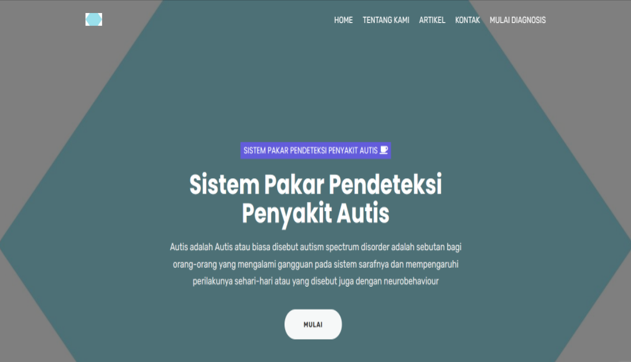Main Article Content
Abstract
Autism Syndrome Disorder is a multifaceted developmental disorder of mental function with symptoms of impaired communication, social interaction, and distinctive behavioural patterns. A person with Autism Syndrome Disorder cannot form normal social relationships or communication. They have their world. This condition causes them to be isolated from the surrounding environment. Because the main problem faced in Indonesia is the misdiagnosis of autistic children as mentally retarded, so they cannot get the necessary treatment that allows these children to live like normal children. The diagnosis of autism is considered a big problem because the symptoms are easily confused with those of mental retardation. Diagnosis is one of the most challenging and complex problems due to the lack of specialist doctors who can diagnose it scientifically, resulting in misdiagnosis or neglect of autism in the early stages of a child's life, which leads to difficulties in intervention later in life. Successful intervention requires a correct diagnosis. Diagnosing autism disorders manually requires a specialist doctor, making this system have many shortcomings and weaknesses. Therefore, applying an expert system can help diagnose autistic disorders in patients. This expert system will be able to diagnose and obtain accurate results. Based on the results of system testing that has been carried out, it was found that of the 12 cases tested using the expert system, there was 1 case that should have had autism. However, the system diagnosed it as harmful, and 1 case should not have had autism, but the system diagnosed autism. So, it can be concluded that the system's accuracy rate for diagnosing autism is 83%
Keywords
Article Details

This work is licensed under a Creative Commons Attribution-NonCommercial 4.0 International License.
References
- Soetjiningsih, I Gusti Ayu Trisna Windiani, and I Gusti Agung Ngurah Sugitha Adnyana, “Pedoman Pelatihan Deteksi Dini dan Diagnosis Gangguan Spektrum Autisme,” pp. 40–46, 2015.
- K. Munir, I. Murtadha, F. Shahbodin, and L. S. Riza, “Expert sistem using the educational game to determine children’s autism levels using forward chaining. Linguistics and Culture Review, 5 (S1), 1149 …,” vol. 5, no. May, pp. 1149–1172, 2021.
- S. Hansun, “Implementasi Algoritm Rete Pada Sistem Pakar Untuk Mendeteksi Autism Spectrum Disorder Berbasis Web,” no. March 2015, pp. 55–62, 2016.
- A. E. Bazama and R. Alsanussi, “The Use of Expert Systems in the Diagnosis of Autism Spectrum Disorder,” ResearchGate, Jan. 2024, [Online]. Available: https://www.researchgate.net/publication/377466640_The_Use_of_Expert_Systems_in_the_Diagnosis_of_Autism_Spectrum_Disorder.
- S. Sajjad, H. Qamar, K. Tariq, and S. Bano, “Development of a diagnostic expert sistem for autism disorder-PCADEX,” Proc. 2011 Int. Conf. Artif. Intell. ICAI 2011, vol. 2, no. April 2012, pp. 934–938, 2011.
- E. Fuad, R. Aminullah, S. Soni, and Y. Rizki, “Expert Sistem Diagnosa Gangguan Autisme Secara Dini Pada Anak dengan Metode Forward Chaining,” Build. Informatics, Technol. Sci., vol. 3, no. 4, pp. 728–737, 2022, doi: 10.47065/bits.v3i4.1413.
- M. Pembelajaran, “Sistem Pakar”.
- R. Lourenzutti and R. A. Krohling, “The Hellinger distance in Multicriteria Decision Making: An illustration to the TOPSIS and TODIM methods,” Expert Syst. Appl., vol. 41, no. 9, pp. 4414–4421, 2014, doi: 10.1016/j.eswa.2014.01.015.
- A. Nasser and B. S, “Medical expert sistems,” Inf. Sci. (Ny)., vol. 162, no. 2, pp. 63–64, 2004, doi: 10.1016/j.ins.2004.03.001.
- R. Dhika Priyatna et al., “Smart application for autism diagnosis in toddlers using the naive bayes method in langkat regency,” J. Infokum, vol. 10, no. 5, pp. 880–891, 2022, [Online]. Available: http://infor.seaninstitute.org/index.php/infokum/index
- G. Mendelson, Diagnostic and statistical manual of mental disorders, fourth edition (DSM-IV), vol. 29, no. 3. 1995. doi: 10.3109/00048679509064964.
- W. Yulianti, D. Arisandi, and A. Syaf, “Comparison of the effectiveness of Certainty Factor vs dempster-shafer in the determination of the adolescent learning styles,” Proc. - 2018 2nd Int. Conf. Electr. Eng. Informatics Towar. Most Effic. W. Mak. Deal. with Futur. Electr. Power Syst. Big Data Anal. ICon EEI 2018, no. October, pp. 46–50, 2018, doi: 10.1109/ICon-EEI.2018.8784313.
- E. Y. Rachmawati, B. Prasetiyo, and R. Arifudin, “The Comparison between Bayes and Certainty Factor Method of Expert Sistem in Early Diagnosis of Dengue Infection,” Sci. J. Informatics, vol. 5, no. 2, pp. 159–170, 2018, doi: 10.15294/sji.v5i2.15740.

